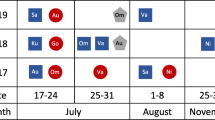Abstract
Infant development in lion-tailed monkeys was observed during the first eight weeks after birth. A rapid decrease in the time spent in the closest association by the mother and the infant was seen between the first and second weeks. Between the second and fifth week there was a somewhat steady state with only marginal decrease in the time spent by the infant out of lap of the mother. However, during this time, a rapid decline in maternal cradling and restraining behaviour was seen. From the sixth week onwards, there was a rapid increase in the time spent by the infant out of contact with the mother. Independence of the infant during troop progression was seen only towards the eighth week, that too only marginal. Among the troop members the subadult females and the juvenile females showed the maximum interest in the infant. The former spent much more time than the juveniles interacting with the infant. The adult females showed only little interest in the infant while the adult male showed no interest at all. Infant snatching by subadult females and juvenile females was seen on many occasions. The infant remained in the possession of them from less than 1 min to more than 2 hr. This behaviour tended to decrease towards the sixth week.
Similar content being viewed by others
References
Altmann, J., 1974. Observational study of behaviour: Sampling methods.Behaviour, 40: 227–267.
Bourliere, F., C. Hunkeler &M. Bertrand, 1970. Ecology and behaviour of Lowe's guenon (Cercopithecus campbelli lowei), in the Ivory Coast. In:Old World Monkeys,J. R. Napier &P. H. Napier (eds.), Academic Press, New York, pp. 297–351.
Dunbar, R. I. M. &E. P. Dunbar, 1974. Behaviour related to birth in wild gelada baboons (Theropithecus gelada).Behaviour, 50: 185–191.
Hill, C. A., 1964. Baby-sitting phenomenon of Kikuyu Colobus monkeys.Zoonooz, 37(6): 7.
Hrdy, B., 1977.The Langurs of Abu. Harvard Univ. Press, Cambridge.
Jay, P., 1963. The langur monkey,Presbytis entellus. In:Primate Social Behaviour,C. H. Southwick (ed.), Van Nostrand, Princeton, pp. 114–123.
Jensen, G. D., R. A. Bobbit &B. N. Gordon, 1967. The development of mutual independence in mother-infant pig-tailed monkeys,Macaca nemestrina. In:Social Communication among Primates,S. A. Altmann (ed.), Univ. of Chicago Press, Chicago, pp. 43–53.
Kurup, G. U., 1978. Distribution, habitat and status survey of the liontailed macaque,Macaca silenus.J. Bombay Nat. Hist. Soc., 75(2): 321–340.
Lancaster, J., 1971. Play mothering: the relations between juvenile females and young infants among free ranging vervet monkeys (Cercopithecus aethiops).Folia Primatol., 15: 161–182.
Lindburg, D. G., 1971. The rhesus monkey in North India: an ecological and behavioural study. In:Primate Behaviour Developments in Field and Laboratory Research. Vol. 2,L. A. Rosenblum (ed.), Academic Press, New York, pp. 1–106.
Ojha, P. R., 1979. Infant snatching behaviour in rhesus monkey,Macaca mulatta. Proc. 7th Congr. Intern. Primatol. Soc., Bangalore, p. 109. (Abstract)
Poirier, F. E., 1968. The Nilgiri langur (Presbytis johnii) Mother-infant dyad.Primates, 9: 45–68.
————, 1970. The Nilgiri langur (Presbytis johnii) of South India. In:Primate Behaviour, Vol. 1,L. A. Rosenblum (ed.), Academic Press, New York, pp. 254–383.
Rahman, H. &M. D. Parthasarathy, 1962. Studies of the social behaviour of bonnet monkeys.Primates., 10: 149–162.
Struhsaker, T. T., 1967. Ecology of vervet monkeys,Cercopithecus aethiops in the Masai, Amboseli Game Reserve, Kenya,Ecology, 48: 891–904.
Sugiyama, Y., 1965. Behavioral development and social structure in two troops of Hanuman langurs (Presbytis entellus).Primates, 6: 213–247.
————, 1968. The ecology of the lion-tailed macaque.J. Bombay Nat. Hist. Soc., 65(2): 283–292.
Author information
Authors and Affiliations
About this article
Cite this article
Kumar, A., Kurup, G.U. Infant development in the lion-tailed macaque,Macaca silenus (Linnaeus): The first eight weeks. Primates 22, 512–522 (1981). https://doi.org/10.1007/BF02381243
Received:
Accepted:
Issue Date:
DOI: https://doi.org/10.1007/BF02381243




